Toward Decision-Making Support: Valuation and Mapping of New Management Scenarios for Tunisian Cork Oak Forests
Abstract
1. Introduction
2. Materials and Methods
2.1. Case Study
2.2. Biophysical Valuation Methods
2.3. Total Economic Value and Economics Valuation Methods
2.4. Mapping and Spatial Distribution
2.5. Management Scenarios
3. Results
3.1. Economic Valuation
3.2. Total Economic Value of the Investigated Services
3.3. Management Scenarios Results
4. Discussion
5. Conclusions
Author Contributions
Funding
Acknowledgments
Conflicts of Interest
References
- Westman, W.E. How much are nature’s services worth. Science 1977, 197, 960–963. [Google Scholar] [CrossRef] [PubMed]
- Gómez-Baggethun, E.; de Groot, R.; Lomas, P.L.; Montes, C. The history of ecosystem services in economic theory and practice: From early notions to markets and payment schemes. Ecol. Econ. 2010, 69, 1209–1218. [Google Scholar] [CrossRef]
- De Groot, R.; Brander, L.; van der Ploeg, S.; Costanza, R.; Bernard, F.; Braat, L.; Christie, M.; Crossman, N.; Ghermandi, A.; Hein, L.; et al. Global estimates of the value of ecosystems and their services in monetary units. Ecosyst. Serv. 2012, 1, 50–61. [Google Scholar] [CrossRef]
- Pascual, U.; Balvanera, P.; Díaz, S.; Pataki, G.; Roth, E.; Stenseke, M.; Watson, R.T.; Başak Dessane, E.; Islar, M.; Kelemen, E.; et al. Valuing nature’s contributions to people: The IPBES approach. Curr. Opin. Environ. Sustain. 2017, 26–27, 7–16. [Google Scholar] [CrossRef]
- Danley, B.; Widmark, C. Evaluating conceptual definitions of ecosystem services and their implications. Ecol. Econ. 2016, 126, 132–138. [Google Scholar] [CrossRef]
- Ehrlich, P.; Ehrlich, A. Extinction. The Causes and Consequences of the Disappearance of Species. Q. Rev. Biol. 1982, 57, 343. [Google Scholar]
- Ehrlich, P.R.; Mooney, H.A. Extinction, Substitution, and Ecosystem Services. Bioscience 1983, 33, 248–254. [Google Scholar] [CrossRef]
- Costanza, R.; Arge, R.; De Groot, R.; Farberk, S.; Grasso, M.; Hannon, B.; Limburg, K.; Naeem, S.; O’Neill, R.V.; Paruelo, J.; et al. The value of the world’s ecosystem services and natural capital. Nature 1997, 387, 253–260. [Google Scholar] [CrossRef]
- Merlo, M.; Croitoru, L. Valuing Mediterranean Forests: Towards Total Economic Value; CABI Publishing: Wallingford, UK, 2005; ISBN 0851999972. [Google Scholar]
- Heal, G.M.; Barbier, E.B.; Boyle, K.J.; Covich, A.P.; Gloss, S.P.; Hershner, C.H.; Hoehn, J.P.; Pringle, C.M.; Polasky, S.; Segerson, K.; et al. Valuing Ecosystem Services: Toward Better Environmental Decision-Making; THE NATIONAL ACADEMIES PRESS: Washington, DC, USA, 2005; ISBN 978-0-309-09318-7. [Google Scholar]
- Turner, R.K.; Daily, G.C. The Ecosystem Services Framework and Natural Capital Conservation; Springer: Dordrecht, The Netherlands, 2008; Volume 39. [Google Scholar]
- Hanley, N.; Barbier, E.B. Pricing Nature: Cost-benefit Analysis and Environmental Policy; Edward Elgar Publishing: London, UK, 2009; ISBN 184980205X. [Google Scholar]
- Millennium Ecosystem Assessment. Ecosystems and Human Well-Being: Synthesis; Island Press: Washington, DC, USA, 2005; ISBN 1-59726-040-1. [Google Scholar]
- Kumar, P. The Economics of Ecosystems and Biodiversity: The Ecological and Economic Foundations; Earthscan: London, UK; Washington, DC, USA, 2009. [Google Scholar]
- De Groot, R.S.; Wilson, M.A.; Boumans, R.M.J. A typology for the classification, description and valuation of ecosystem functions, goods and services. Ecol. Econ. 2002, 41, 393–408. [Google Scholar] [CrossRef]
- Boyd, J.; Banzhaf, S. What are ecosystem services? The need for standardized environmental accounting units. Ecol. Econ. 2007, 63, 616–626. [Google Scholar] [CrossRef]
- Wallace, K.J. Classification of ecosystem services: Problems and solutions. Biol. Conserv. 2007, 139, 235–246. [Google Scholar] [CrossRef]
- Fisher, B.; Turner, R.K.; Morling, P. Defining and classifying ecosystem services for decision making. Ecol. Econ. 2009, 68, 643–653. [Google Scholar] [CrossRef]
- Ojea, E.; Martin-Ortega, J.; Chiabai, A. Defining and classifying ecosystem services for economic valuation: The case of forest water services. Environ. Sci. Policy 2012, 19–20, 1–15. [Google Scholar] [CrossRef]
- Haines-young, R.; Potschin, M. Common International Classification of Ecosystem Services (CICES); European Environment Agency: Nottingham, UK, 2013. [Google Scholar]
- IPBES Preliminary Guide Regarding Diverse Conceptualization of Multiple Values of Nature and Its Benefits, Including Biodiversity and Ecosystem Functions and Services; Intergovernmental Science-Policy Platform on Biodiversity and Ecosystem Services: Bonn, Germany, 2015.
- Tardieu, L. The need for integrated spatial assessments in ecosystem service mapping. Rev. Agric. Food Environ. Stud. 2017, 98, 173–200. [Google Scholar] [CrossRef]
- FAO (Food and Agriculture Organization of The United Nations). DGF (Direction Générale des Forêts), Evaluation économique des biens et services des forêts tunisiennes; Daly-Hassen, H., Croitoru, L., Tounsi, K., Aloui, A., Jebari, S., Eds.; Food and Agriculture Organization: Rome, Italy, 2012. [Google Scholar]
- Stiti, B. Analyse du potentiel de croissance et de production dans une forêt de chêne-liège en Kroumirie. Ph.D. Thesis, Université Tunis El Manar Faculté, Tunis, Tunisia, 2017. [Google Scholar]
- Daly-hassen, H.; Mansoura, A. Ben Private and Social Values derived from a Tunisian cork oak agroforestry production system. In Proceedings of the XIII World Forestry Congress, Nairobi, Kenya, 23–28 August 2009; p. 11. [Google Scholar]
- Chebil, A.; Ovando, P.; Daly-Hassen, H. Total commercial income from a cork oak forest agroforestry system in the region of Iteimia. In Cork Oak Woodlands and Cork Industry: Present, Past and Future; Museu del Suro de Palafrugell: Palafrugell, Spain, 2009; pp. 514–535. [Google Scholar]
- Campos, P.; Daly-Hassen, H.; Ovando, P. Cork oak forest management in Spain and Tunisia: Two case studies of conflicts between sustainability and private income. Int. For. Rev. 2007, 9, 610–626. [Google Scholar] [CrossRef]
- Direction Générale des Forêts Résultats du premier inventaire pastoral national en Tunisie; DGF Tunisie: Tunis, Tunisia, 1995.
- Sebei, H.; Chaar, H.; Stiti, B.; Montero, G. Evaluation of the aboveground biomasses of cork oak (Quercus suber). In Cork Oak Woodlands and Cork Industry: Present, Past and Future; Zapato, S., Ed.; Museu del Suro de palafrugell: Girona, Spain, 2009; p. 170. [Google Scholar]
- Data Were Obtained as Results of Hydrological Modeling, Obtained from Work Package Activities in the Framework of the “Integrated Research on Forest Resilience and Management in the Mediterranean” (INFORMED) Project (2015–2017). Available online: https://www6.inrae.fr/informed-foresterra_eng (accessed on 31 December 2019).
- Ovando, P.; Caparrós, A.; Diaz-Balteiro, L.; Pasalodos, M.; Beguería, S.; Oviedo, J.L.; Montero, G.; Campos, P. Spatial Valuation of Forests’ Environmental Assets: An Application to Andalusian Silvopastoral Farms. Land Econ. 2017, 93, 87–108. [Google Scholar] [CrossRef]
- Croitoru, L. Valuing the non-timber forest products in the Mediterranean region. Ecol. Econ. 2007, 63, 768–775. [Google Scholar] [CrossRef]
- Malinga, R.; Gordon, L.J.; Jewitt, G.; Lindborg, R. Mapping ecosystem services across scales and—A review. Ecosyst. Serv. 2015, 13, 57–63. [Google Scholar] [CrossRef]
- Häyhä, T.; Franzese, P.P.; Paletto, A.; Fath, B.D. Assessing, valuing, and mapping ecosystem services in Alpine forests. Ecosyst. Serv. 2015, 14, 12–23. [Google Scholar] [CrossRef]
- Tammi, I.; Mustajärvi, K.; Rasinmäki, J. Integrating spatial valuation of ecosystem services into regional planning and development. Ecosyst. Serv. 2017, 26, 329–344. [Google Scholar] [CrossRef]
- Pandeya, B.; Buytaert, W.; Zulkafli, Z.; Karpouzoglou, T.; Mao, F.; Hannah, D.M. A comparative analysis of ecosystem services valuation approaches for application at the local scale and in data scarce regions. Ecosyst. Serv. 2016, 22, 250–259. [Google Scholar] [CrossRef]
- National Water Distribution Utility Sonede. Available online: http://www.sonede.com.tn/index.php?id=12&L=2 (accessed on 4 October 2019).
- Ben Zaied, Y.; Ben Cheikh, N.; Nguyen, P. Modeling nonlinear water demand: The case of Tunisia. Econ. Bull. 2017, 37, 637–644. [Google Scholar]
- Potthast, M.; Daly-hassen, H.; Gader, G. Analyse de la vulnérabilité des écosystèmes forestiers tunisiens face au changement climatique et conséquences socio-économiques associées; Gesellschaft für Technische Zusammenarbeit (GIZ): Bonn, Germany, 2005. [Google Scholar]
- European Environment Agency. Climate Change, Impacts and Vulnerability in Europe 2012; European Environment Agency: Copenhagen, Denmark, 2012. [Google Scholar]
- Daly-Hassen, H.; Gader, G.; Potthast, M.C. Une approche économique pour choisir les options d ’ adaptation des forêts au changement climatique: Application à la forêt de chêne liège en Tunisie. In Proceedings of the XIVème Congrès Forestier Mondial, Durban, South Africa, 7–11 September 2015. [Google Scholar]
- Ben Mansoura, A.; Garchi, S.; Daly, H. Analyzing forest users’ destructive behavior in Northern Tunisia. Land Use Policy 2001, 18, 153–163. [Google Scholar] [CrossRef]
- World Bank Group/DGF (Direction Générale des Forêts). Stratégie de développement durable des forêts et des parcours en Tunisie 2015–2024; The World Bank Group: Washington, DC, USA, 2015. [Google Scholar]
- Indufor Oy. Indufor Financing for Sustainable Forest Management in Tunisia; Country Case Study Prepared by H. Daly; Indufor Oy: Helsinki, Finland, 2012. [Google Scholar]
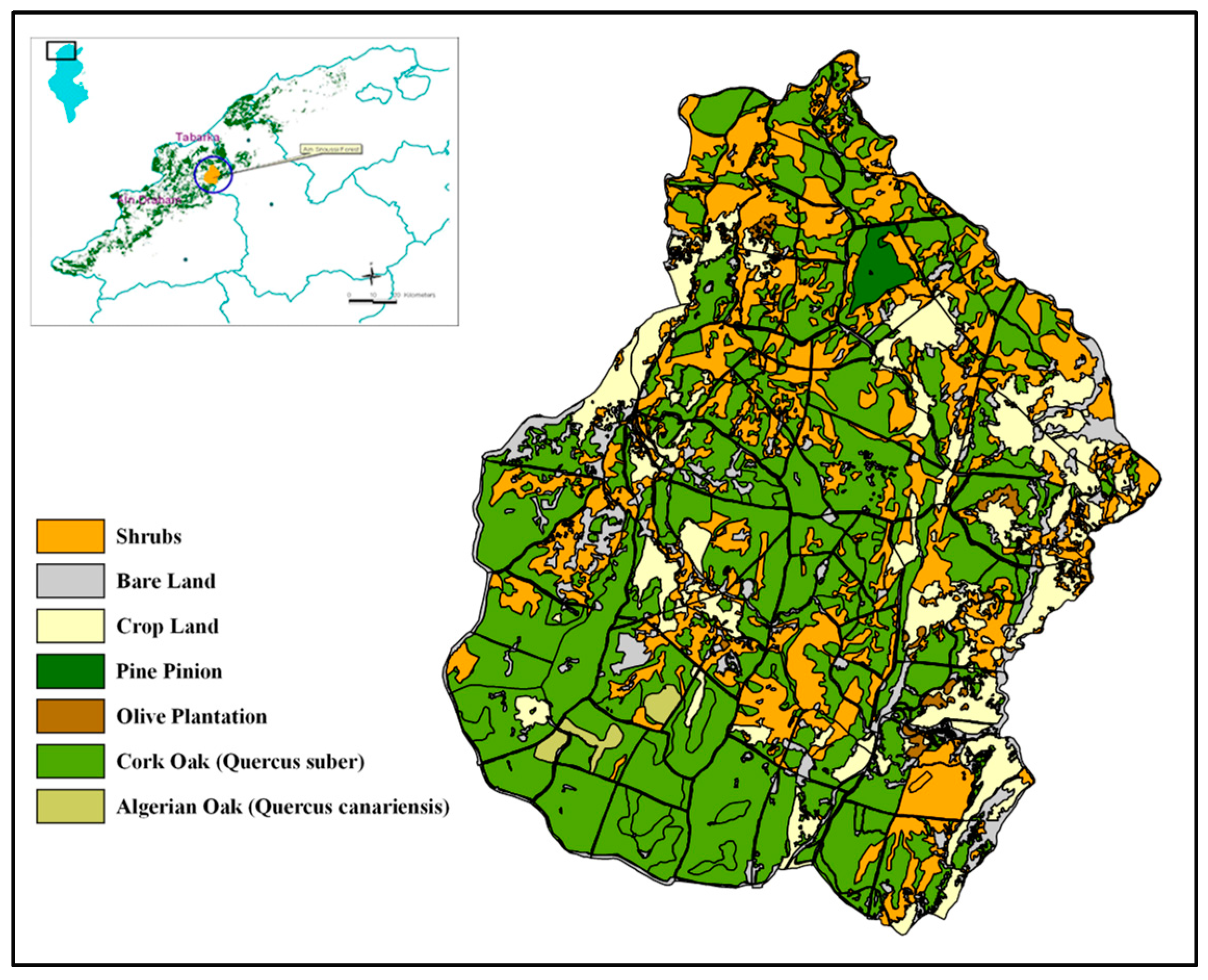
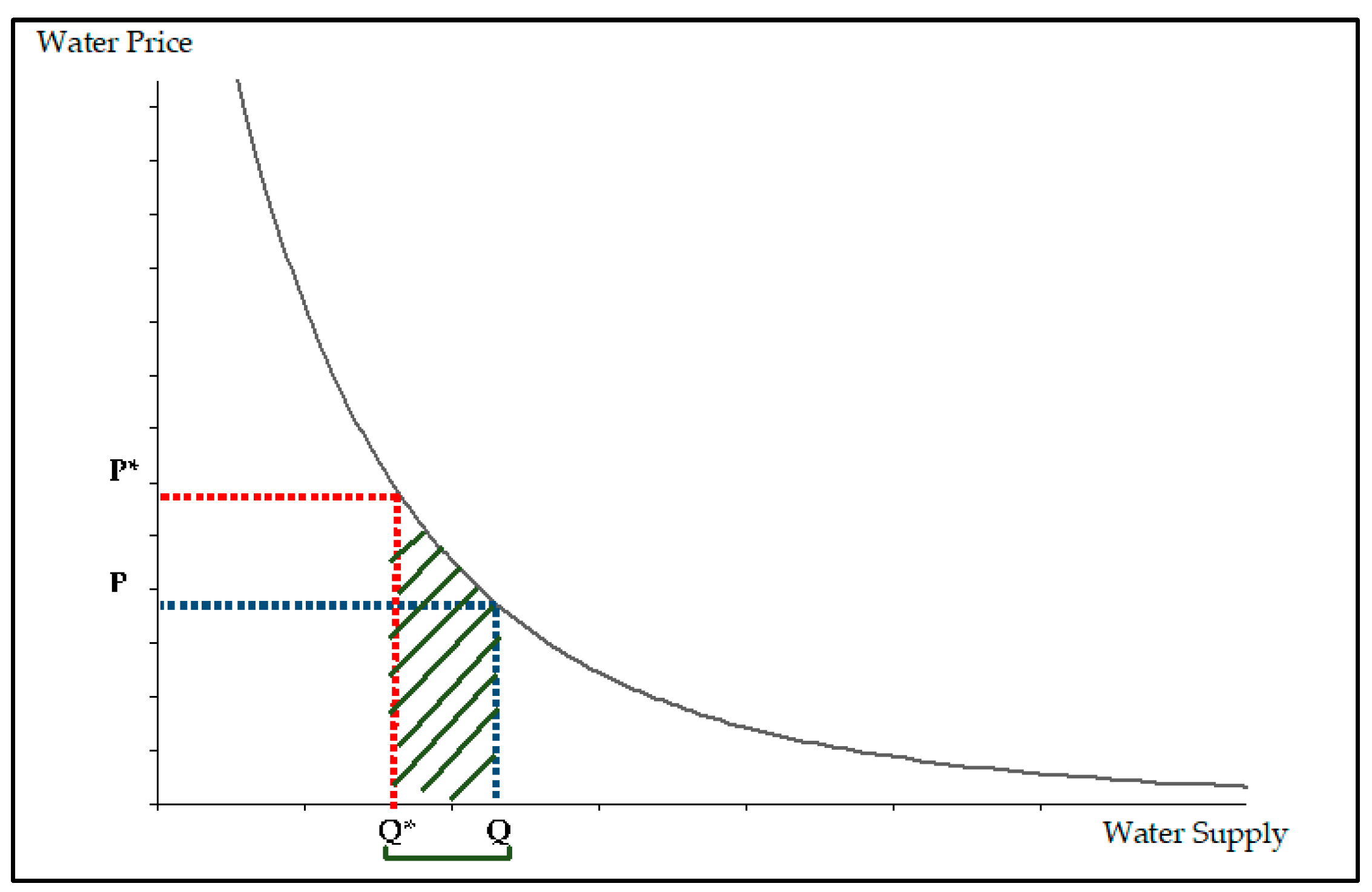
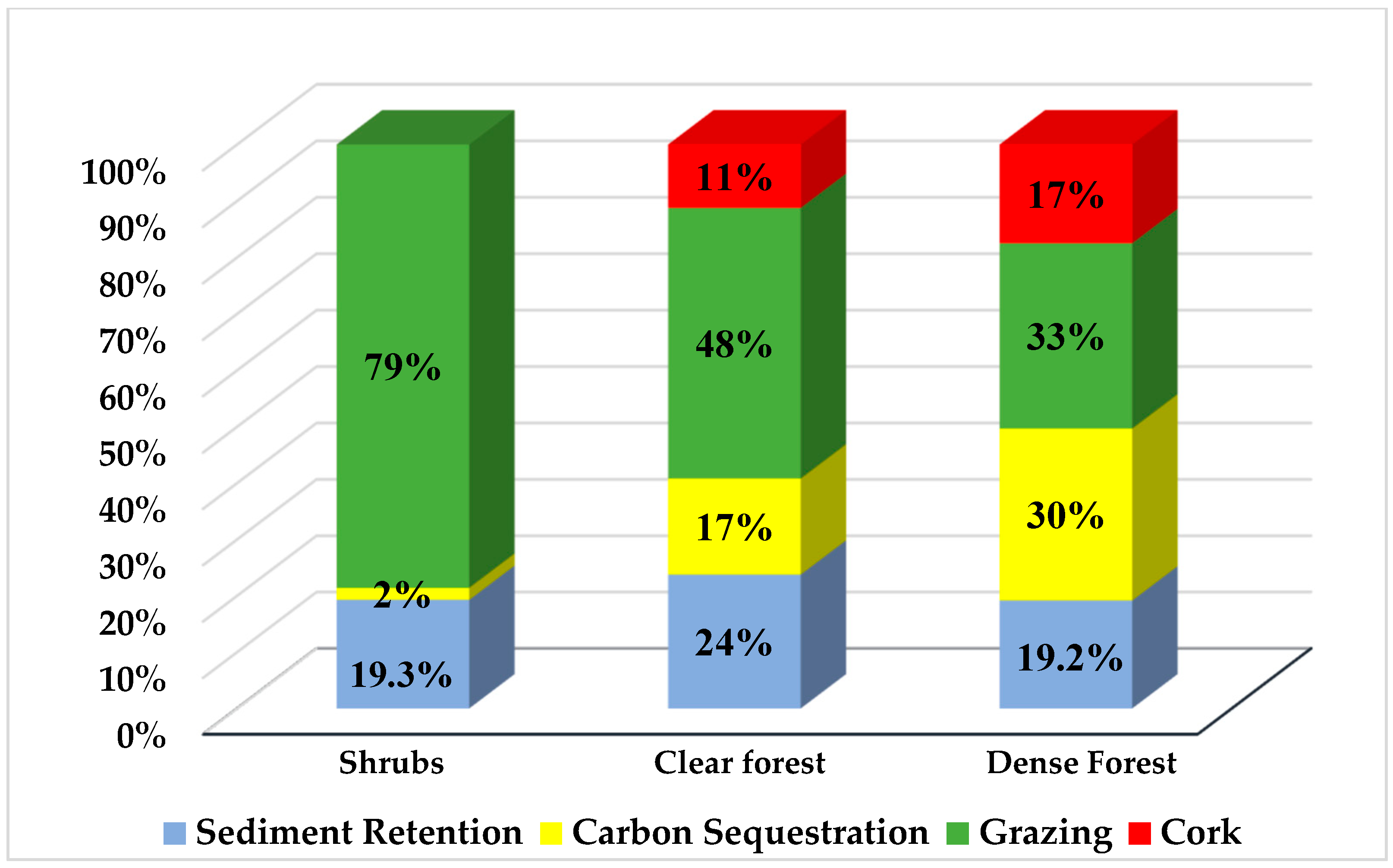
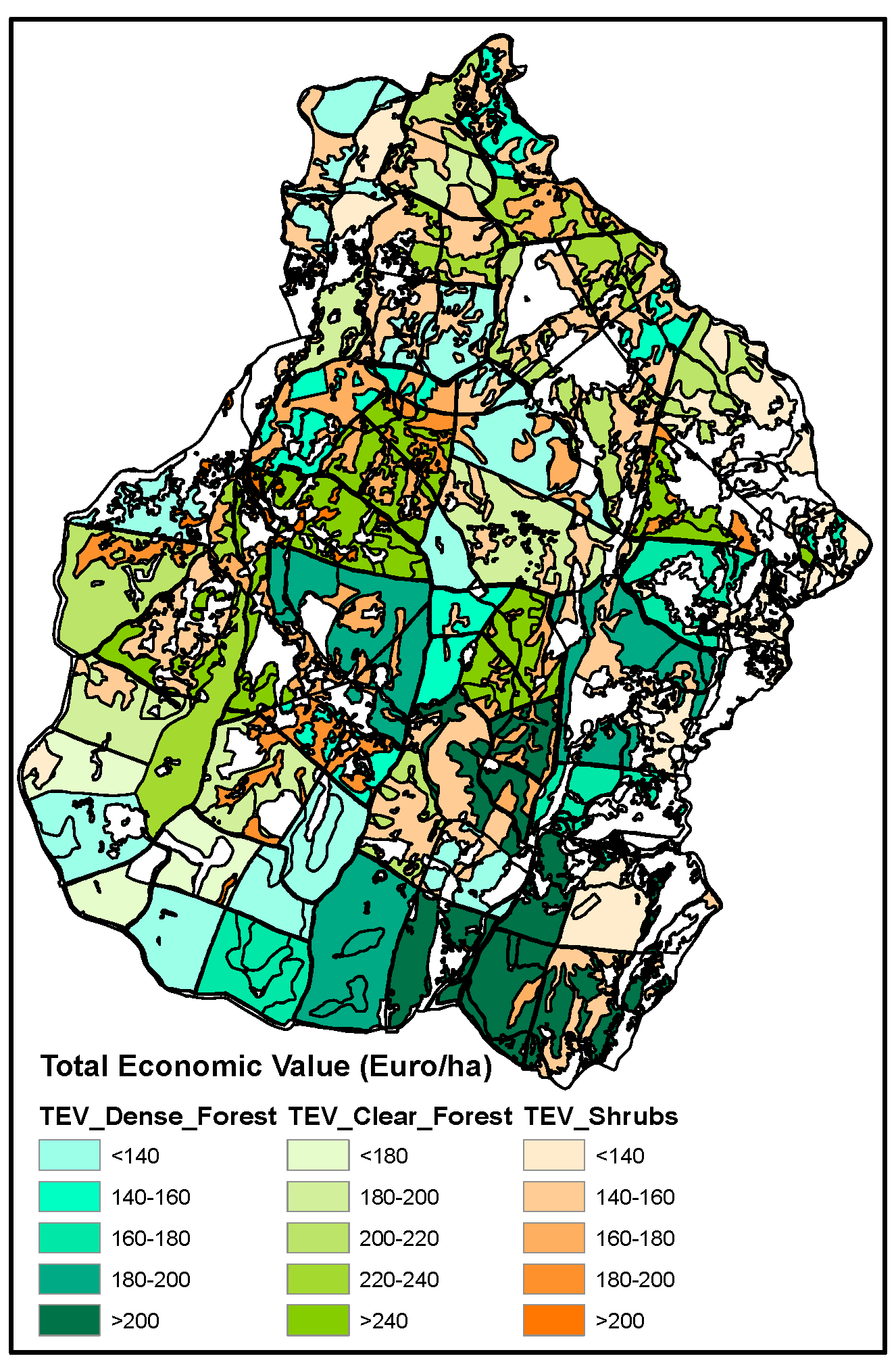
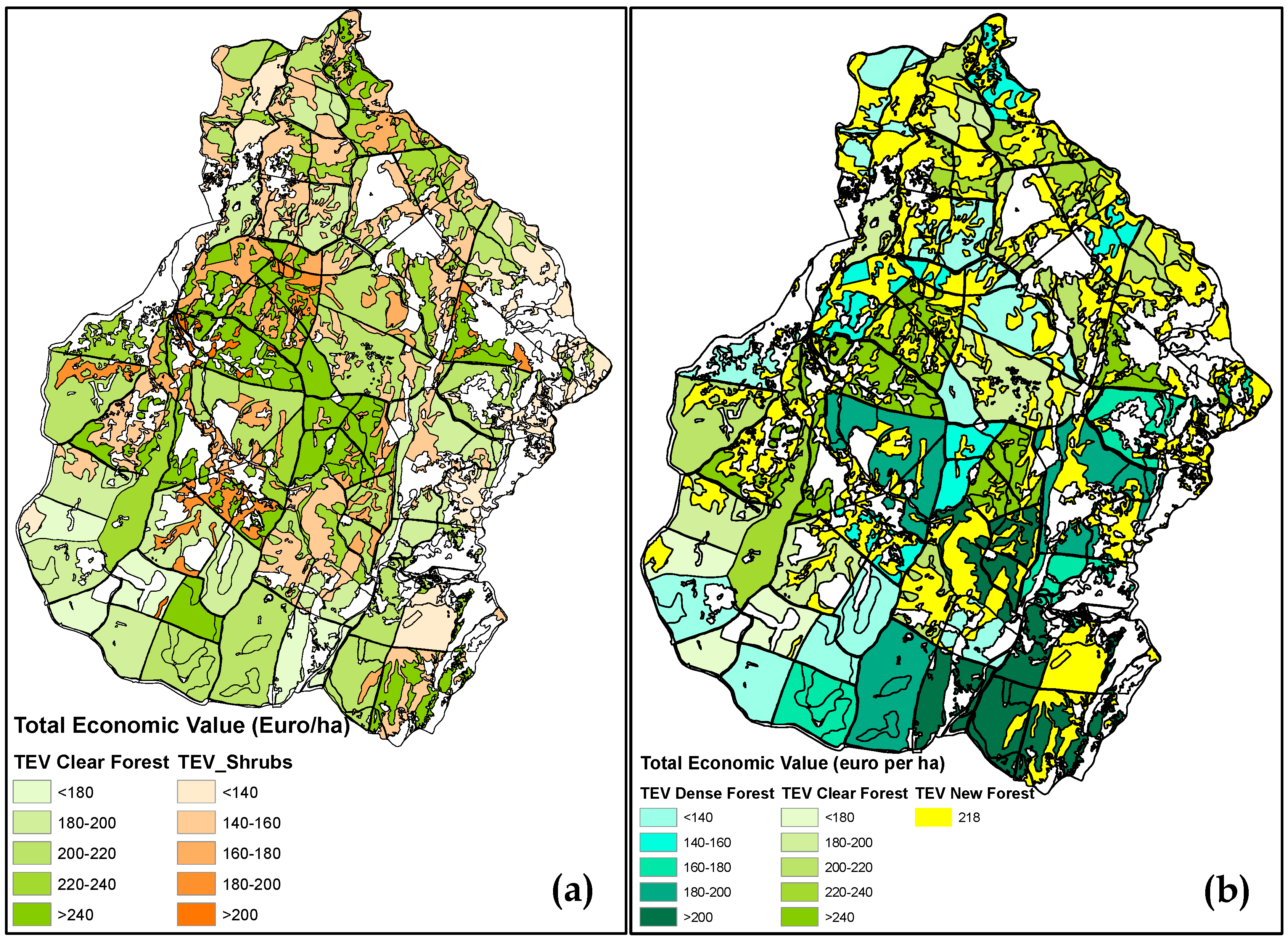
| Ecosystem Service | Unit (per ha) | Average Quantity | Biophysical Valuation Method | |||
|---|---|---|---|---|---|---|
| Shrubs | Clear Forest | Dense Forest | ||||
| Sediment retention | m3 | 5.23 | 9.10 | 7.07 | RUSLE model | |
| Carbon sequestration | T | 0.11 | 1.24 | 2.16 | Biophysical models | |
| Grazing | FU | 639 | 550 | 363 | Grazing potential per land cover type | |
| Cork | Reproductive | Q | 0.81 | 1.17 | Average production collected in 12years | |
| Virgin | 0.02 | 0.05 | ||||
| Miscellaneous | 0.03 | 0.09 | ||||
| Surface Area | ha | 920.00 | 816.38 | 1095.56 | ||
| Ecosystem Service | TEV per Land Cover Type (Millions of €) | Total Forest (Clear and Dense) | TEV Ain Snoussi (Millions of €) | ||
|---|---|---|---|---|---|
| Shrubs | Clear Forest | Dense Forest | |||
| Sediment Retention | 0.027 | 0.04 | 0.04 | 0.09 | 0.11 |
| Carbon Sequestration | 0.003 | 0.03 | 0.07 | 0.10 | 0.10 |
| Grazing | 0.11 | 0.09 | 0.08 | 0.16 | 0.27 |
| Cork | 0.02 | 0.04 | 0.06 | 0.06 | |
| Total Value (Millions of €) | 0.14 | 0.18 | 0.23 | 0.41 | 0.55 |
| Surface Area (ha) | 920.00 | 816.38 | 1095.564 | 2831.94 | |
| Average Value (€/ha) | 154.5 | 217.7 | 210.2 | - | 194.3 |
| Scenario 1: Forest Density Decrease | ||||||
| TEV per Land Cover (Millions of €/year) | TEV (Millions of €) | Difference to BAU | ||||
| Shrubs | Clear Forest | Dense Forest | New Plantation | |||
| Sediment Retention | 0.03 | 0.13 | - | - | 0.16 | 40% |
| Carbon Sequestration | 0.003 | 0.07 | - | - | 0.07 | −33% |
| Grazing | 0.11 | 0.20 | - | - | 0.31 | 14% |
| Cork | - | 0.05 | - | - | 0.05 | −22% |
| TEV (Millions of €) | 0.14 | 0.40 | - | - | 0.54 | −2% |
| Surface Area (ha) | 920.0 | 1911.9 | - | - | 2831.94 | - |
| Average Value (€/ha) | 157.4 | 207.2 | 191.02 | - | 157.4 | - |
| Scenario 2: Afforestation of Shrub Area | ||||||
| Sediment Retention | - | 0.05 | 0.11 | 0.05 | 0.21 | 83% |
| Carbon Sequestration | - | 0.03 | 0.07 | 0.03 | 0.13 | 30% |
| Grazing | - | 0.09 | 0.08 | 0.10 | 0.26 | −6% |
| Cork | - | 0.02 | 0.04 | 0.02 | 0.08 | 37% |
| TEV (Millions of €) | - | 0.18 | 0.30 | 0.20 | 0.68 | 24% |
| Surface Area (ha) | - | 816.38 | 1095.56 | 920.00 | 2831.94 | - |
| Average Value (€/ha) | - | 222.70 | 274.62 | 217.81 | 241.19 | - |
© 2020 by the authors. Licensee MDPI, Basel, Switzerland. This article is an open access article distributed under the terms and conditions of the Creative Commons Attribution (CC BY) license (http://creativecommons.org/licenses/by/4.0/).
Share and Cite
Khalfaoui, M.; Daly-Hassen, H.; Stiti, B.; Jebari, S. Toward Decision-Making Support: Valuation and Mapping of New Management Scenarios for Tunisian Cork Oak Forests. Forests 2020, 11, 197. https://doi.org/10.3390/f11020197
Khalfaoui M, Daly-Hassen H, Stiti B, Jebari S. Toward Decision-Making Support: Valuation and Mapping of New Management Scenarios for Tunisian Cork Oak Forests. Forests. 2020; 11(2):197. https://doi.org/10.3390/f11020197
Chicago/Turabian StyleKhalfaoui, Mariem, Hamed Daly-Hassen, Boutheina Stiti, and Sihem Jebari. 2020. "Toward Decision-Making Support: Valuation and Mapping of New Management Scenarios for Tunisian Cork Oak Forests" Forests 11, no. 2: 197. https://doi.org/10.3390/f11020197
APA StyleKhalfaoui, M., Daly-Hassen, H., Stiti, B., & Jebari, S. (2020). Toward Decision-Making Support: Valuation and Mapping of New Management Scenarios for Tunisian Cork Oak Forests. Forests, 11(2), 197. https://doi.org/10.3390/f11020197






